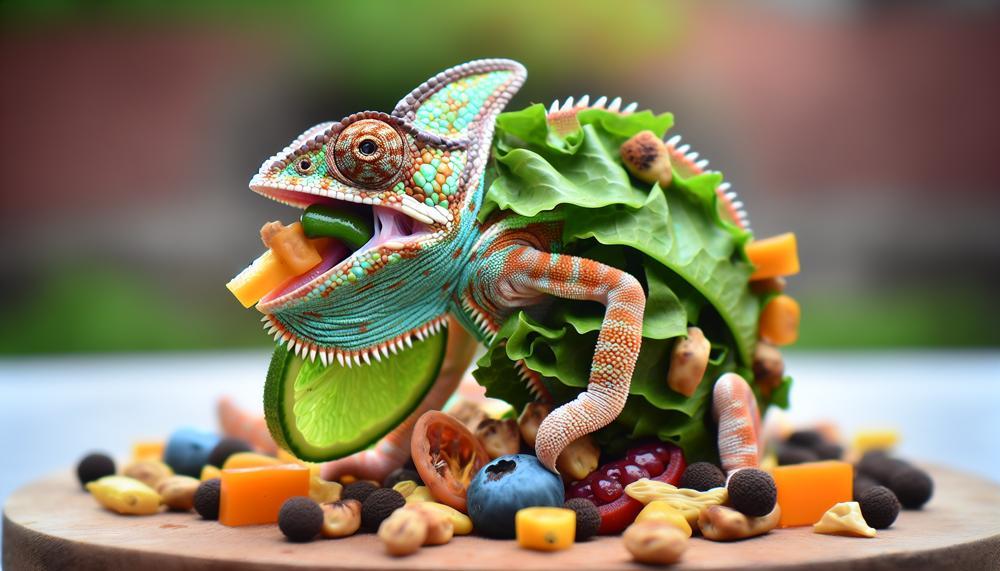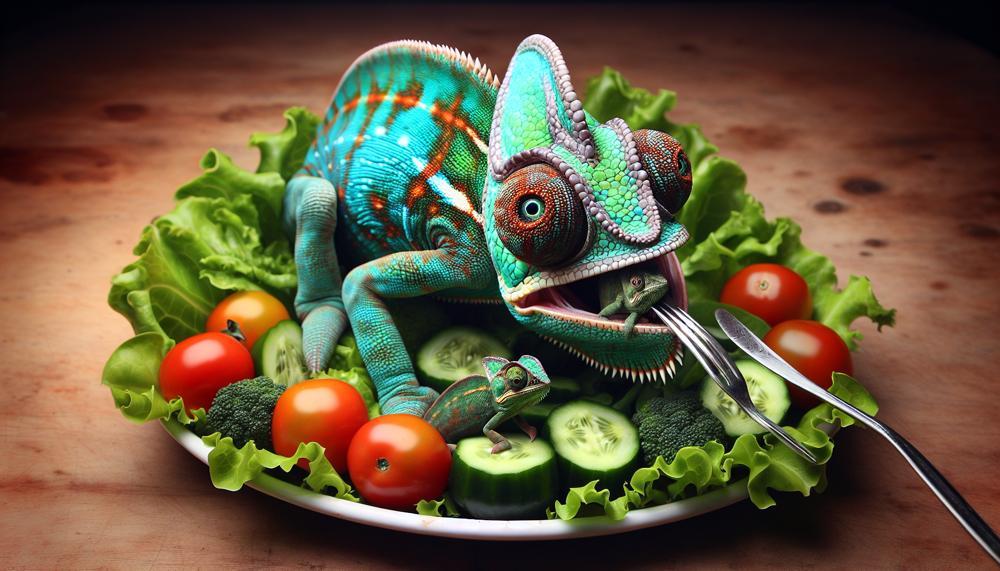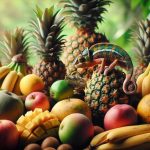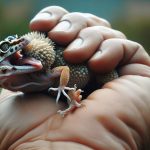Have you ever pondered upon the dietary habits of chameleons? These mesmerizing creatures are renowned for their color-changing abilities, but did you know that their diet is just as intriguing?
Prepare to be captivated as we delve into the world of chameleons and their delectable meals.
- Chameleons are insectivores, meaning they primarily consume insects like crickets, grasshoppers, and mealworms.
- However, they also have a carnivorous side and relish small reptiles and birds, making them omnivores.
- Due to their slow metabolism, chameleons only need to eat a few times per week.
- In captivity, it’s crucial to offer a diverse range of insects and ensure they are loaded with nutritious fruits and vegetables before feeding them to your chameleon.
- Calcium and vitamin supplements play a vital role in maintaining strong bones and overall well-being in chameleons.
- Some species of chameleons also enjoy indulging in flowers and leaves for added hydration.
- It’s imperative to research the specific dietary requirements of your chameleon species to guarantee they receive all the essential nutrients.
Now that you’re familiar with the healthy diet of these extraordinary creatures, you can truly appreciate their unique eating patterns.
So, next time you witness a chameleon changing its hues or capturing prey with its elongated sticky tongue, remember how crucial their diet is for their happiness and health.
Contents
- 1 What Do Chameleons Eat in the Wild?
- 2 What Do Chameleons Eat as Pets?
- 3 Can Chameleons Eat Fruit?
- 4 What Are The Best Foods a Chameleon Can Eat?
- 5 What Do Chameleons Eat Tasty Treats Healthy Diet?
- 6 A Balanced Diet for Chameleon Health
- 7 What Food Shouldn’t I Feed My Chameleon?
- 8 How Often Should I Feed My Chameleon?
- 9 Tips for a Healthy Chameleon Diet
- 10 Conclusion
What Do Chameleons Eat in the Wild?
Chameleons in their natural habitat primarily feed on insects, with occasional consumption of small lizards and birds.
However, insects make up the majority of their diet. To supplement their water intake, some chameleon species may also consume plant material and berries.
In captivity, it is recommended to stick to an insect-based diet for chameleons as it is easier to provide a diverse range of prey. But it’s important to note that chameleons require a balanced diet to ensure they receive all the necessary nutrients for their growth and overall well-being.
This can be achieved by feeding them gut-loaded insects and dusting their food with calcium supplements. Additionally, offering tasty treats like waxworms, silkworms, hornworms, and fruit flies can add variety to their diet. It’s crucial to closely monitor their food intake to prevent health issues such as metabolic bone disease.
By understanding the natural eating habits of chameleons in the wild, we can provide our pet chameleons with a wholesome and nourishing diet in captivity.
What Do Chameleons Eat as Pets?
When it comes to keeping chameleons as pets, their dietary needs are of the utmost importance and must be carefully considered.

A balanced diet of insects and greens, gut-loaded insects, vitamin supplementation, and regular misting for hydration are all essential for maintaining their health and wellbeing.
However, there are also certain foods that should be avoided to prevent harm to the chameleons, such as acidic fruits, mealworms, and mice.
| Food | Recommended | Avoid |
| Insects (crickets, roaches, silkworms) |
|
|
| Greens (collard greens, mustard greens, dandelion greens) |
|
|
| Vitamin Supplements (calcium, D3, multivitamins) |
|
|
| Mice or other fatty foods | N/A | Avoid entirely due to high fat content leading to health issues. |
| Water |
|
|
Chameleons have specific dietary requirements that must be met to ensure their overall health and wellbeing. It is crucial to provide a varied and balanced diet, while also avoiding certain harmful foods.
Additionally, regular hydration through misting and access to a water source is vital for maintaining their health.
Can Chameleons Eat Fruit?
While it is safe for chameleons to consume fruit as part of their diet, it should not be the main component. As omnivores, chameleons have a varied diet that includes insects, small vertebrates, and some plant matter.
While fruit can provide hydration and essential nutrients, it should only be given occasionally as a treat. It is important to note that not all fruits are suitable for chameleons, so it is crucial to research and consult with a reptile veterinarian before introducing any new foods to their diet.
In captivity, it is essential to replicate the natural diet of chameleons, which primarily consists of insects. While pet chameleons may enjoy fruit, relying on it as the primary food source can lead to health issues such as obesity and vitamin deficiencies.
To maintain a healthy lifestyle in captivity, chameleons require a balanced diet that mimics their natural feeding habits.
Supplementation also plays a crucial role in enhancing the nutrient intake of chameleons. It is important to understand their specific nutritional needs and provide proper supplementation, such as calcium and vitamin D.
Water is also crucial for hydration and meeting essential needs for chameleons. Regular misting and providing fresh water daily are vital for their overall health.
What Are The Best Foods a Chameleon Can Eat?
Chameleons, being insectivores, should primarily be fed a diet of insects. However, there are some treats that they can enjoy in moderation. These include:
- Crickets: These high-protein and easily digestible insects are a staple food for chameleons. They also provide a good source of calcium when fed a nutritious diet.
- Dubia roaches: Another excellent source of protein and calcium, these roaches are easy to digest and have a low risk of causing impaction in chameleons.
- Hornworms: These moisture-rich caterpillars can help keep your chameleon hydrated. They are also packed with essential vitamins and minerals.
- Silk worms: High in protein and containing essential fatty acids, these worms contribute to healthy shedding and overall well-being.
- Leafy greens: While not considered a treat, many chameleons enjoy eating greens such as collard greens and turnip greens. These provide crucial vitamins and minerals for a balanced diet.
- Superworms: These larger worms should only be given as an occasional treat due to their high fat content. However, they are an excellent source of protein and can help underweight chameleons gain weight.
- Waxworms: Another high-fat treat, waxworms should only be given in moderation. They can be used as a reward during training or to entice picky eaters to consume their regular food.
- Fruits: As mentioned before, fruits should be given sparingly due to their acidic content. However, some safe options include papaya, mangoes, and figs. Be sure to remove any seeds or pits before feeding them to your chameleon.
Chameleons have specific dietary needs that must be met for them to thrive. As responsible reptile owners, it’s essential to understand what foods are suitable for our scaly friends and what should only be given in moderation.
While insects are their main food source, chameleons can also enjoy some treats to add variety to their diet. However, it’s crucial to be mindful of the quantity and frequency of these treats to prevent any potential health issues.
Crickets and dubia roaches are excellent sources of protein and calcium for chameleons. Hornworms and silk worms provide essential vitamins and minerals, while leafy greens offer a balanced diet. Superworms and waxworms can be given as occasional treats but should not be a regular part of their diet due to their high fat content.
Fruits, although enjoyed by chameleons, should only be given sparingly due to their acidic nature. Some safe options include papaya, mangoes, and figs, but make sure to remove any seeds or pits before feeding them to your chameleon.
What Do Chameleons Eat Tasty Treats Healthy Diet?
Chameleons, with their exceptional ability to blend into their surroundings, are fascinating creatures. Their diet plays a pivotal role in maintaining their health and well-being. Just as we humans have our favorite foods, chameleons too have their flavor preferences.
Let’s delve into the culinary world of chameleons and explore their delectable treats that make up a healthy diet.
| Food Items | Nutritional Value | Health Benefits |
| Crickets | High in protein, calcium, and essential vitamins | Supports muscle growth, bone development, and overall vitality |
| Mealworms | Rich in protein, fat, and minerals | Provides energy, promotes healthy skin and scales |
| Dubia roaches | Excellent source of protein, calcium, and other nutrients | Supports growth, maintains healthy immune system |
| Superworms | High in protein, fat, and calcium | Aids in muscle function, promotes bone growth |
| Silkworms | Packed with protein, vitamins, and minerals | Enhances overall well-being, contributes to a healthy reproductive system |
A Balanced Diet for Chameleon Health
A diverse and balanced diet is essential for chameleons to thrive. Their nutritional needs vary depending on their age, size, and species. However, some general guidelines apply to all chameleons.
- Protein: Protein is the cornerstone of a chameleon’s diet. It is crucial for muscle development, tissue repair, and overall body functioning. Live insects are the best source of protein for chameleons, as they provide a natural balance of nutrients.
- Calcium: Calcium is another vital nutrient for chameleons. It is essential for strong bones and healthy teeth. Calcium deficiency can lead to metabolic bone disease, a serious condition that affects bone growth and development.
- Vitamins and Minerals: Chameleons also require a variety of vitamins and minerals to maintain good health. These nutrients are essential for various bodily functions, including metabolism, immune system health, and reproduction.
- Water: Water is an essential component of a healthy diet for chameleons. They obtain water by drinking it directly or absorbing it through their skin. Providing a clean, fresh water source is crucial for a chameleon’s well-being.
What Food Shouldn’t I Feed My Chameleon?
Properly nourishing chameleons is essential for their overall vitality and happiness. It’s equally crucial to be aware of which foods are unsuitable for them, as this can safeguard against potential health problems and encourage natural behaviors.
By comprehending the significance of a balanced diet for chameleons, pet owners can offer their companions the highest level of care.
When it comes to feeding chameleons, there are certain foods that should be avoided. Citrus fruits, such as oranges and lemons, can be too acidic or bitter for these reptiles and may cause them to reject the offering.
Certain parts of fruits, such as seeds and cores, can also be toxic to chameleons, even if the fruit itself is safe for consumption. For example, apples, peaches, apricots, and other pitted fruits can contain harmful elements.
So, when feeding these types of fruits, it’s important to always cut them away from the core before offering them to your chameleon.
On the other hand, there are some foods that are safe and beneficial for chameleons to eat. These include insects such as crickets and mealworms, as well as leafy greens like collard greens and dandelion leaves.
These foods provide important nutrients and support natural behaviors in chameleons.
How Often Should I Feed My Chameleon?
Determining the best feeding schedule for your chameleon depends on their age and species. For baby chameleons, it is recommended to feed them 12 small insects per day, divided into two feedings. As they grow, juvenile chameleons should be fed daily, while adult chameleons can be fed every other day or a few times a week.
When it comes to offering a variety of insects, it’s important to ensure a balanced diet for your chameleon. This includes crickets, mealworms, waxworms, and roaches. To further enhance their diet, gut-loading these insects with calcium-rich foods like leafy greens, carrots, and squash is highly recommended.
Gut-loading is an essential process in which insects are fed nutrient-rich foods so that your chameleon receives those nutrients when consuming the insects. This is especially crucial for young chameleons who are still growing and developing.
In addition to age and species, there are other factors that play a role in determining the best feeding schedule for your chameleon. These include temperature and humidity levels in their enclosure, as well as their level of activity and overall health status.
Tips for a Healthy Chameleon Diet
Here are a few tips to ensure your chameleon receives a healthy and nutritious diet:
- Variety is Key: Offer a variety of live insects to your chameleon to ensure they receive a balanced diet. This also prevents them from becoming bored with their food.
- Gut Loading: Gut loading is the process of feeding live insects nutritious foods before offering them to your chameleon. This ensures that the insects are packed with essential nutrients that the chameleon can absorb.
- Calcium and Vitamin D3 Supplementation: Chameleons may require additional calcium and vitamin D3 supplements to meet their nutritional needs. Consult with a veterinarian to determine the appropriate dosage for your chameleon.
- Fresh Water: Always provide clean, fresh water for your chameleon. Change the water daily to prevent bacterial growth.
Conclusion
In conclusion, the eating habits of chameleons are just as intriguing as their remarkable color-changing abilities. These captivating creatures are primarily insectivores, but they also have a carnivorous side and enjoy indulging in small reptiles and birds.
In captivity, it is crucial to offer a varied diet of insects that are enriched with nutritious fruits and vegetables before feeding them to your chameleon. Calcium and vitamin supplements are essential for maintaining their overall health and well-being.
Additionally, some species of chameleons also enjoy consuming flowers and leaves for added hydration. It is important to research the specific dietary requirements of your chameleon species to ensure they receive all the necessary nutrients.
By understanding the natural feeding behaviors of chameleons in the wild, we can provide our pet chameleons with a wholesome and nourishing diet in captivity. Remember to prioritize a balanced diet of insects, supplemented with occasional treats like waxworms or fruit flies.






